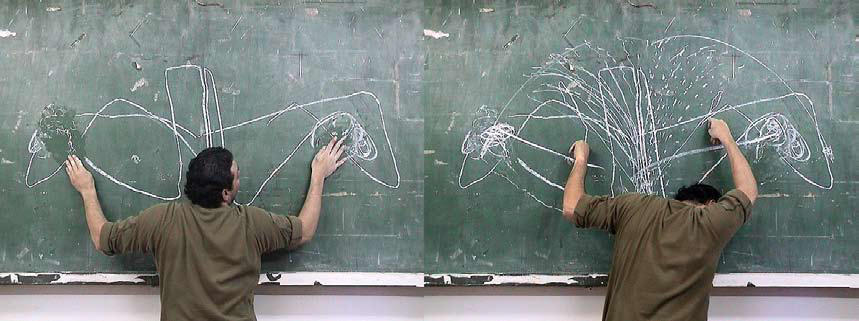
Cairo
What’s Happening Now?
Palace of Arts
December 9, 2007–February 5, 2008
A group exhibition held this past winter at Cairo’s Palace of Arts, ‘What’s Happening Now?’ seemed to mark a shift in the often-staid politics of the Egyptian art scene. Curated by the institution’s new director, Mohamet Talaat, the selection of thirty-three artists ranged from sixty-something pillars of the art establishment to younger artists active in the independent sector.
Given the bifurcation of the Egyptian scene into independent and official, contemporary and traditional, the presentation of all these artists under one roof seemed a laudable step. Here was a chance to engage with work independently of the baggage of affiliation and tendentious identity politics.
Still, the old order exerted its influence. On entering the main gallery hall, viewers were met by the works of some of the most favored stars of the establishment, some of which might have been better suited to the buffed halls of the Ministry of Tourism. The hieroglyphics, abstract gold-leaf calligraphy, and futuristic metal assemblages of Farouk Wahba, Emad Abu zeid, and Adel Tharwat presented an unsubtle celebration of Egyptian identity. Complementing those works was a video by Susan Hefuna, an artist who lives between Egypt and Germany. In Ana/Ich, a black screen displayed the word Ana (Arabic for “I”) in large font, while a sound track presented voices repeating the word over and over.
Complexity and nuance were notably lacking in many works, which featured untheorized nostalgia for an exalted Egyptian past, along with facile criticism of the West. Hazem Taha Hussein’s Memories from the East on the Way to Münster, a series of photographs that negotiated identity and memory through countless layers of Photoshopping, demonstrated the problem. The sixteen black and white images juxtaposed “symbols showing the culture of Eastern societies” — idyllic scenes of children playing on the street, old fishermen pulling in the day’s catch, street vendors, and quaint weddingdress stores — with memories of his train rides in Germany, including text on an LED destination board and faint images of a scantily clad female model on a billboard. The effect was frustratingly glib and simplistic.
‘What’s Happening Now?’ claimed to be an exhibition of new works produced during the month of September 2007 at a governmentsponsored workshop. But several of the works, independent productions like Wael Shawky’s video The Cave (2005) and Amal Kenawy’s You Will Be Killed (2006), had been exhibited earlier in other venues. Indeed, the administration later retracted its claim, explaining that the framework of the workshop had not been suitable for all of the artists. In the end, only a few engaged with the idiom of the “workshop” per se.
George Fikry, for example, presented a video installation, Everything Is Alright, the product of a workshop he held on the grounds with young artists and former students of the Faculty of Arts. The installation included his signature collaborative charcoal drawings hanging in a stairwell; the centerpiece of the installation was a video documentary of each participant’s response to the question, “What’s happening now in Egyptian reality?” It was, the artist explained, an opportunity to reflect on the prevailing economic and social situation in Cairo. (The answer, from the evidence on display here: not so much.)
Mohamed Abla and Shady El Noshokaty, for their part, were more successful in thinking about the event. Both are also arts educators and have been active in organizing workshops as elements of their teaching in recent years. El Noshokaty presented a video, A Lecture in Theory. It was the second part of his ongoing project Stammer, initiated in June of last year, in which the artist gets up before a class and barks out terms and definitions, drawing diagrams with abandon until his etchings become a web of indefinable lines and squiggles and he begins to stutter. It was tempting to consider this work in light of the theoretical rigidity of the arts academies in Egypt and arts education at large. Abla, for his part, presented Out of Water, highlighting his recent feud with the government over the planned expulsion of the inhabitants of Qursaya Island to make way for urban development. Using photographs of the villagers and an interactive aerial map of the island with pop-up windows that presented the inhabitants’ personal stories, as well as newspaper clippings about the lawsuits, he made his case and invited the audience to sign a petition on a black wall in the space.
Hassan Khan presented a new two-channel video work called Host. In front of the video, a raised platform held a sound mixer and speakers playing the artist’s musical compositions — what he described as “invitations” to view the work as a machine of thinking about perceptive and conceptual processes. On the left screen were the “conceptual processes” — scenes of three actors improvising a performance of life in an imaginary mental hospital. It was a discomfiting video of jittery handheld shots of the performers, half-dressed in something between underclothes and doctors’ uniforms, rebelling, waiting, assaulting, entrapped. On the right, a red screen was said to represent “modes of perception”; it slowly shifted into shades of another color.
Khan described the work as “a springboard for the exploration of the drives and dualities latent within civilization and its power structures.” There in the middle of the Palace of Arts — the official gallery of the Ministry of Culture — his rumination on civilization and power seemed an especially productive one.